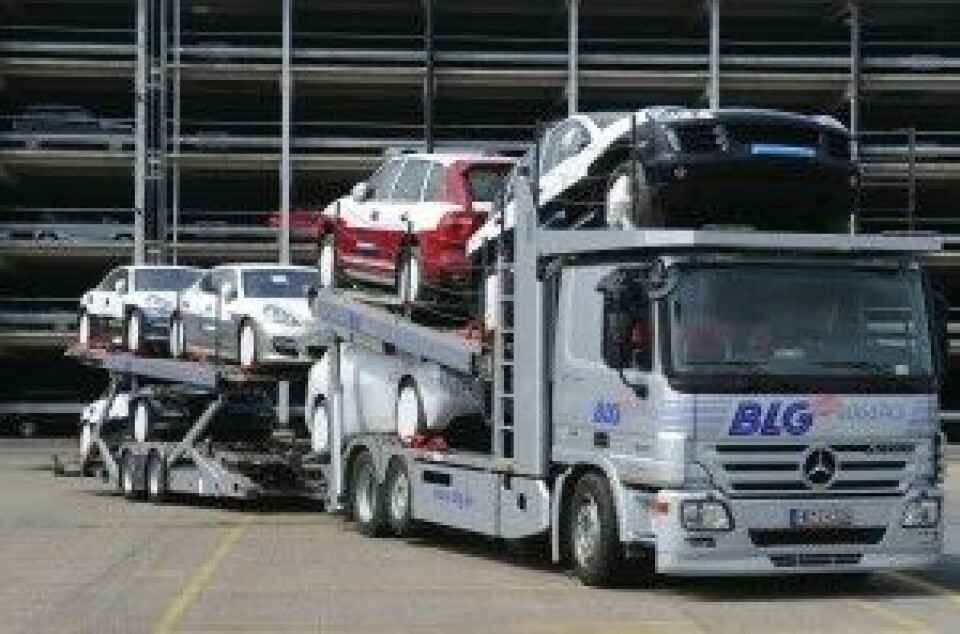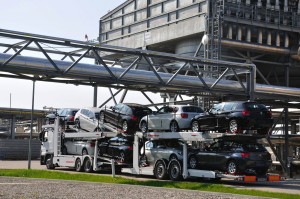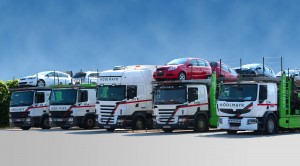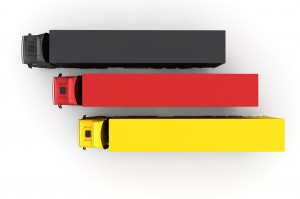Pushing Europe's boundaries
Many barriers prevent a truly international, borderless vehicle logistics service across European countries. However, carmakers and logistics providers are making progress toward integrated networks.
Political, economic and diplomatic tensions are rising in Europe, with the escalating issues surrounding Russia and Ukraine, and looming threats of Greece crashing out of the euro-zone, or even Britain quitting the EU. There are fears that splits within Europe could disturb the relative peace and integration that has occurred for 20 years or more.
In the business world and especially the automotive industry, such divisions have significant impacts, as the sinking Russian and Ukrainian markets show all too well. Meanwhile, within the EU, automotive logistics experts join many other businesses in pushing Brussels and member states to pursue free trade further and complete the still fragmented single European market. While signs of progress can be spotted, regulations have never been completely harmonised and some industries and services remain protected at national levels. A recent wave of Eurosceptic sentiment has certainly done little to deepen economic integration.
In this story...
For more on the German minimum wage and other EU issues, read here
This muddle of harmonisation and fragmentation is especially true for finished vehicle logistics in Europe, an industry that had for decades operated in highly national or localised networks. While many parts of the industry have benefitted from attempts at creating a single market in Europe, not least the creation of the single currency and the removal of many borders and custom barriers, logistics providers still operate among many restrictions. Among them are cabotage laws that limit the use of equipment registered in one country from operating in another. Another is the ‘patchwork’ of legislation concerning things like vehicle carrier length, height and permitted overhang for loaded trucks.
However, customer demands for quality and price go well beyond national borders or technical requirements for truck lengths. Carmakers have also sought to increase economies of scale within their networks by seeking out pan-European services.
“This is the optimal strategic approach to ensure a robust future,” says David Dyke, global materials planning and logistics director at Jaguar Land Rover. “When approaching strategic decisions, we consider Europe as a whole region and try to make transport decisions based on the demographics for the whole of Europe, rather than by each country.”
In response, vehicle logistics providers from many European countries have been expanding their reach, including the management of regional distribution centres and the use of multimodal logistics across countries.
Disparities and regulatory difficulties aside, many logistics providers are pushing the boundaries of their operations. Companies such as Gefco already run a number of long haul, multi-country routes, including from Vigo, Spain to Bratislava in Slovakia, or between Prague in the Czech Republic and Warsaw in Poland to Russia. Last year STVA transported 2m cars by road, and is operating across the UK, France, Germany, Romania, Poland, and Spain.
Germany’s BLG has seen significant European expansion over the past 20 years, moving away from its base in Germany and into the surrounding markets as far as Russia, and with plans to continue developments. Michael Blach, member of the executive board at BLG Logistics Group says, “We are working to improve our services and trying to see, in the wake of the economic crisis, which are the new services that may be interesting and relevant to the marketplace.”
Some executives point out that European integration is a relatively new phenomenon, going back barely two decades, and is still in the process of developing. Austria’s Hödlmayr, for example, is today running a mix of both country specific vehicle compounds to serve local markets, as well as cross-continental services. According to Konrad Zwirner, senior vice-president of international sales and business development, there has been a significant shift over the past two decades towards a more regional form of distribution.
“We have experienced the integration of Europe from very fragmented markets in different countries, different distribution schemes and different flows,” he says. “In the 90s we had a lot of local compounds, but then, when eastern European countries entered the EU, it became more regional compounds, so there’s already some integration.”

STVA, part of French state rail group SNCF, used to operate on a national basis, before OEM demands changed this. According to Jean-Michel Floret, chairman of STVA’s executive board, the company previously had very national organisations, relying on a network of compounds that served dealers on a local basis. “Our strength was to rely on a dense compound network that allowed us to cover the last mile to reach the dealers while adding dedicated and tailored services,” he says.
Today, however, Floret says that OEMs want more direct and long distance distribution than before, with significant cost reductions. “They have adapted their own production, so there is less volume and fewer storage compounds,” says Floret. “Now, when distributing in France, for example, you need only one compound because that is what the OEMs want. We have to adapt to that.”
BLG’s Blach explains that, because of continuous cost evaluation by OEMs, the number of compounds continues to evolve. “[You] aim for a constant gravitation towards the most cost-effective set up. Sometimes this may call for fewer compounds. At other times it may call for more compounds, or compounds in different places.”

While some logistics companies are now providing pan-European logistics, they often need to work with other companies to achieve this. “There are, in general, some logistics companies that are able to provide pan-European logistics concepts, but there is not one company that is able to do that with its own assets,” says Michael Bünning, director of sales and marketing at BLG. “You can manage those flows and those vehicles but you cannot do it with your own assets. You need partner companies and other companies who are doing the real job. Every company has a strength in some markets, but not in every single country in Europe.”
To achieve coverage across more of Europe, STVA works with subcontractors, but Floret stresses that the company follows several procedures to maintain a high level of quality. The company now works with more than 30 subcontractors and ensures full compliance with all legal requirements, completes regular audits, and makes sure the companies are meeting STVA’s own standards in terms of insurance, financial stability and excellence.
Despite progress towards pan-European vehicle logistics, Zwirner acknowledges that Europe remains far apart on many issues, including truck sizes, cabotage and driving hours. The euro crisis and subsequent uncertainty have also raised questions and challenges, from driver salaries to taxes. “We have lots of laws regarding things like driving time, when the driver can return home during his work week, and many other regulations, so it is difficult to manage,” says Zwirner.
John Stocker, finished vehicle logistics director of Gefco UK – the UK branch of the France-based provider – agrees that Europe-wide vehicle logistics is a reality, even though barriers remain. “If you’re talking about, ‘is it a market where vehicles are moved in a harmonised and in a synchronised way’, then yes,” he says. “However, if you’re saying, ‘is it a market in which every single market could be exactly the same as another one’, the answer would be no because of various differences.”
Andrea Conti, director of finished vehicle logistics at the Gefco Group, who oversees operations across Gefco’s national units, explains that differing tax and custom formalities are among the chief challenges for operating in a pan-European way, as not all of these rules are harmonised across the EU.
JLR’s David Dyke sees these difficulties within the EU and also with its neighbours and key trading partners in the greater region, including Turkey and Russia. “The European landscape is continuously changing and with this comes challenges such as unique custom requirements for non-EU markets, border delays, technical constraints and legislation for certain modes of transport, such as rail gauge, load factors, and driving hours,” he says.
Even language can be a barrier to expanded service, especially considering the quality checks and handover processes when delivering a vehicle to a dealer. “Many drivers from foreign countries going to a dealer don’t speak the dealer language so there are some difficulties,” Zwirner notes.
Floret also points to legal and technical constraints that carriers must overcome before they can manage international services. “The legal requirements change and we have to adapt. We are aware of the environmental constraints and we need to invest to provide logistics solutions with the best materials to take care of the environment,” he says.
However, he also acknowledges that, while adapting to legal requirements is a must, the real challenge is operational. “It requires a deep knowledge of the national and international networks, multilingual operations and a culture of high responsiveness,” says Floret.
Zwirner agrees that it is part of the job of logistics providers to coordinate all of these difficulties, be it through effective management systems, multi-lingual staff or customs expertise. Conti says that Gefco turns difficulty for customs into strength by offering customs clearance services, for example.
Erik Uyttendaele, director of plant logistics at Volvo Cars Ghent, also suggests that these difficulties could be seen as opportunities. “For me it’s not something pan-European, it’s about transportation itself,” he says. “Those who are able to balance their flows in the best way are most successful.”
Steven Harley, a retired Ford executive who led its European and later its global logistics, and who today is president of Elupeg, a cross-industry logistics organisation, adds that logistics operators have to find a way around the difficulties. That might mean breaking up journeys into several routes or transport modes, for example.
“If you want to go international, you have to use methods and products that are capable of achieving all,” he says. “There’s often a compromise in that and so, very often, it will make more sense to do a series of short legs than it would to do a through-delivery. The big benefit, which is encouraged, is to use a multi-modal solution.”
JLR, which builds all of its vehicles for the European market in the UK, has a co-modal approach to European distribution encompassing road, rail and sea, according to Dyke. “All of these are pivotal to ensuring that vehicles are delivered across Europe on time and without damage,” he says.
Another way to smooth the running of logistics operations in Europe is to have a region-wide or global IT system. Gefco’s Conti points to the company’s system for tracking and managing vehicle flows across Europe, covering inbound and outbound logistics in overland groupage and full- or part-load road transport, along with urgent shipments all over Europe.

The company also uses a system specifically for operational outbound data, including vehicle releases, arrival at compounds, post-production work and PDI. All this information is shared with clients to help provide an even service across the continent.
Hödlmayr runs a European-wide IT system that measures every country according to the same standards. “KPIs like lead time, IT tracking, transparency, these are all important as the customer should get the same standard whether they’re in Belgium, Hungary or Romania,” says Zwirner.
Like Gefco, the company shares information with its customers, while also using it internally to improve vehicle dispatch. “The IT system is a critical tool to be successful and efficient when operating in a pan-European way,” he adds.
Although there may be barriers preventing an entirely smooth logistics flow throughout Europe, larger carriers and OEMs aspire to pan-European operations, and in many cases achieve them. Dyke says that JLR is further ahead in EU member states among the 29 European markets to which it exports. In the EU, it has standardised logistics, while for non-EU markets bespoke processes are in place.
Volvo Cars operates in a similar way, basing its mainland European logistics on consolidation from its production plants in Gothenburg, Sweden and Ghent, Belgium. “In Gothenburg we consolidate and explode into all the Scandinavian countries, and in Ghent we explode to all the mainland European countries,” Uyttendaele says. “Then we have different trade links to Russia.”
Gefco, which currently transports 4m finished vehicles a year, is looking for deeper integration of its European network, including plans to create a hub for its vehicle logistics activity in central Europe to improve product flows in the region. “We hope to develop and redesign our logistics activity through new acquisitions, but we don’t want to grow without considering the level of quality – growth and reorganisation are key,” Conti says.
Hödlmayr currently operates in 16 countries in Europe, with an infrastructure that is mixed between local and regional distribution. Within each country there are distribution compounds that carry out pre-delivery inspection and deliver directly to dealers. For long haul, multi-country routes, Hödlmayr uses multimodal logistics through a regional hub system. For example, from Romania, the company transports Renault’s Dacia vehicles by train to a hub in Belgium, where the company carries out PDI, before distributing in Belgium, the Netherlands and Luxembourg.

Hödlmayr also has plans to grow its service further across and deeper within Europe, although Zwirner notes the need to be flexible in the face of market and regulatory barriers.
“The automotive market is moving all the time, and there are some barriers such as Russia and Ukraine where we are hindered in developing our business, but we are trying to find other business areas like the Caucasus, and connecting Spain with central Europe, and the UK with the continent,” he says.
While barriers exist in the new vehicle logistics market, BLG’s Bünning suggests the structure for new car logistics is almost the same across European countries, with minor adjustments. However, he notes that the used car market is more difficult. “Used car handling will be managed completely differently in Germany than in Poland for instance. The expectation of the service quality is different. In this field it is not possible to adapt concepts that are running well here to other countries because the demands are quite different,” Bünning says.
Over the coming years in Europe, consumer habits will continue to evolve, including increased car sharing, and e-commerce, which will affect the vehicle logistics industry and put further demands on integrated, pan-European services. Logistics providers like BLG will need to continue improving their services, while continually managing costs, adapting to new legislation, and becoming greener. Blach says, “As a service provider we need to understand what services are in demand in a particular country, what people are willing to pay for and then we must try to adapt the best we can.”
At STVA, which is also involved in used car logistics, Floret anticipates further disruption and change in the vehicle logistics sector both in individual markets and across the continent.
“The growing shared car market and internet sales will change the business model of our industry and it is already changing,” he says. “Our duty is to help the OEMs and all the players involved to face this changing situation by offering them innovative solutions using our assets or those of our contractors. It means offering good quality standards with a high level of adaptability at a competitive price.”
 Those hoping that the vehicle logistics market might see further integration at a European level have lately been disappointed. The European Commission recently backed away from earlier pledges to eliminate or reduce cabotage laws. And this past December, during negotiations for changes to the directive of weights and measures for transport equipment, legislators failed to agree on a harmonised minimum allowable loading length. Despite a lobby campaign by the Association of European Vehicle Logistics (ECG) to base this at 20.75 metres, including for crossing member state borders (where permitted loading lengths are technically limited to 18.75 metres), MEPs ultimately maintained the disjointed status quo, wherein national standards are maintained (see p78 for more).
Those hoping that the vehicle logistics market might see further integration at a European level have lately been disappointed. The European Commission recently backed away from earlier pledges to eliminate or reduce cabotage laws. And this past December, during negotiations for changes to the directive of weights and measures for transport equipment, legislators failed to agree on a harmonised minimum allowable loading length. Despite a lobby campaign by the Association of European Vehicle Logistics (ECG) to base this at 20.75 metres, including for crossing member state borders (where permitted loading lengths are technically limited to 18.75 metres), MEPs ultimately maintained the disjointed status quo, wherein national standards are maintained (see p78 for more).
With Brussels not always able to apply European-wide standards, national legislation continues to have impacts on logistics services and routes across markets. The German government had intended to apply its newly enacted minimum wage of 8.50euros per hour ($9.20) for all freight truck drivers driving in the country, regardless of origin or destination. Hauliers from eastern Europe have been concerned that the law would have an impact on their business, and challenge the basis for some logistics flows across central Europe, including those that traverse Germany on the way to or from western and eastern Europe.
While the German government has agreed to exclude transit traffic for now, transport with origins or destinations to, from or within Germany will be included. A driver from a foreign company entering Germany will thus be entitled to receive the minimum wage for the period they are working in the country, excluding breaks.
Despite the suspension, the German government maintains it would be legal in the EU to apply the minimum wage to all drivers within German borders. The European Commission is challenging Berlin with concerns that it is yet another barrier against the free movement of goods and services.








